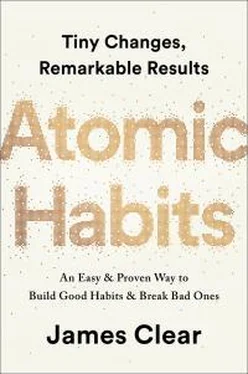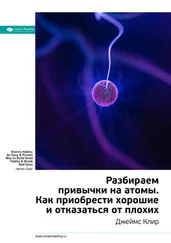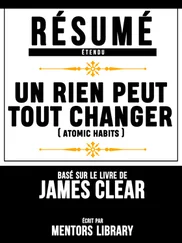Within months, the researchers saw a rapid shift in the health of children in the neighborhood. The rate of diarrhea fell by 52 percent; pneumonia by 48 percent; and impetigo, a bacterial skin infection, by 35 percent.
The long-term effects were even better. “We went back to some of the households in Karachi six years after,” Luby told me. “Over 95 percent of households who had been given the soap for free and encouraged to wash their hands had a handwashing station with soap and water available when our study team visited. . . . We had not given any soap to the intervention group for over five years, but during the trial they had become so habituated to wash their hands, that they had maintained the practice.” It was a powerful example of the fourth and final Law of Behavior Change: make it satisfying.
We are more likely to repeat a behavior when the experience is satisfying. This is entirely logical. Feelings of pleasure—even minor ones like washing your hands with soap that smells nice and lathers well—are signals that tell the brain: “This feels good. Do this again, next time.” Pleasure teaches your brain that a behavior is worth remembering and repeating.
Take the story of chewing gum. Chewing gum had been sold commercially throughout the 1800s, but it wasn’t until Wrigley launched in 1891 that it became a worldwide habit. Early versions were made from relatively bland resins—chewy, but not tasty. Wrigley revolutionized the industry by adding flavors like Spearmint and Juicy Fruit, which made the product flavorful and fun to use. Then they went a step further and began pushing chewing gum as a pathway to a clean mouth. Advertisements told readers to “Refresh Your Taste.”
Tasty flavors and the feeling of a fresh mouth provided little bits of immediate reinforcement and made the product satisfying to use. Consumption skyrocketed, and Wrigley became the largest chewing gum company in the world.
Toothpaste had a similar trajectory. Manufacturers enjoyed great success when they added flavors like spearmint, peppermint, and cinnamon to their products. These flavors don’t improve the effectiveness of toothpaste. They simply create a “clean mouth” feel and make the experience of brushing your teeth more pleasurable. My wife actually stopped using Sensodyne because she didn’t like the aftertaste. She switched to a brand with a stronger mint flavor, which proved to be more satisfying.
Conversely, if an experience is not satisfying, we have little reason to repeat it. In my research, I came across the story of a woman who had a narcissistic relative who drove her nuts. In an attempt to spend less time with this egomaniac, she acted as dull and as boring as possible whenever he was around. Within a few encounters, he started avoiding her because he found her so uninteresting.
Stories like these are evidence of the Cardinal Rule of Behavior Change: What is rewarded is repeated. What is punished is avoided. You learn what to do in the future based on what you were rewarded for doing (or punished for doing) in the past. Positive emotions cultivate habits. Negative emotions destroy them.
The first three laws of behavior change— make it obvious, make it attractive, and make it easy —increase the odds that a behavior will be performed this time. The fourth law of behavior change— make it satisfying —increases the odds that a behavior will be repeated next time. It completes the habit loop.
But there is a trick. We are not looking for just any type of satisfaction. We are looking for immediate satisfaction.
THE MISMATCH BETWEEN IMMEDIATE AND DELAYED REWARDS
Imagine you’re an animal roaming the plains of Africa—a giraffe or an elephant or a lion. On any given day, most of your decisions have an immediate impact. You are always thinking about what to eat or where to sleep or how to avoid a predator. You are constantly focused on the present or the very near future. You live in what scientists call an immediate-return environment because your actions instantly deliver clear and immediate outcomes.
Now switch back to your human self. In modern society, many of the choices you make today will not benefit you immediately. If you do a good job at work, you’ll get a paycheck in a few weeks. If you exercise today, perhaps you won’t be overweight next year. If you save money now, maybe you’ll have enough for retirement decades from now. You live in what scientists call a delayed-return environment because you can work for years before your actions deliver the intended payoff.
The human brain did not evolve for life in a delayed-return environment. The earliest remains of modern humans, known as Homo sapiens sapiens , are approximately two hundred thousand years old. These were the first humans to have a brain relatively similar to ours. In particular, the neocortex—the newest part of the brain and the region responsible for higher functions like language—was roughly the same size two hundred thousand years ago as today. You are walking around with the same hardware as your Paleolithic ancestors.
It is only recently—during the last five hundred years or so—that society has shifted to a predominantly delayed-return environment.* Compared to the age of the brain, modern society is brand-new. In the last one hundred years, we have seen the rise of the car, the airplane, the television, the personal computer, the internet, the smartphone, and Beyoncé. The world has changed much in recent years, but human nature has changed little.
Similar to other animals on the African savannah, our ancestors spent their days responding to grave threats, securing the next meal, and taking shelter from a storm. It made sense to place a high value on instant gratification. The distant future was less of a concern. And after thousands of generations in an immediate-return environment, our brains evolved to prefer quick payoffs to long-term ones.
Behavioral economists refer to this tendency as time inconsistency . That is, the way your brain evaluates rewards is inconsistent across time.* You value the present more than the future. Usually, this tendency serves us well. A reward that is certain right now is typically worth more than one that is merely possible in the future. But occasionally, our bias toward instant gratification causes problems.
Why would someone smoke if they know it increases the risk of lung cancer? Why would someone overeat when they know it increases their risk of obesity? Why would someone have unsafe sex if they know it can result in sexually transmitted disease? Once you understand how the brain prioritizes rewards, the answers become clear: the consequences of bad habits are delayed while the rewards are immediate. Smoking might kill you in ten years, but it reduces stress and eases your nicotine cravings now . Overeating is harmful in the long run but appetizing in the moment. Sex—safe or not—provides pleasure right away. Disease and infection won’t show up for days or weeks, even years.
Every habit produces multiple outcomes across time. Unfortunately, these outcomes are often misaligned. With our bad habits, the immediate outcome usually feels good, but the ultimate outcome feels bad. With good habits, it is the reverse: the immediate outcome is unenjoyable, but the ultimate outcome feels good. The French economist Frédéric Bastiat explained the problem clearly when he wrote, “It almost always happens that when the immediate consequence is favorable, the later consequences are disastrous, and vice versa. . . . Often, the sweeter the first fruit of a habit, the more bitter are its later fruits.”
Put another way, the costs of your good habits are in the present. The costs of your bad habits are in the future.
Читать дальше




![Джеймс Клир - Атомные привычки [Как приобрести хорошие привычки и избавиться от плохих]](/books/403243/dzhejms-klir-atomnye-privychki-kak-priobresti-horosh-thumb.webp)



